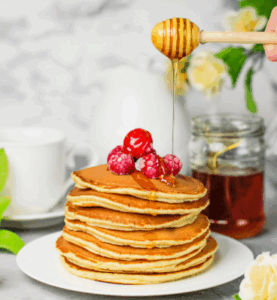
You must have heard this many times before; subjecting honey to heat and consuming it is dangerous.
Is heating honey bad? Is cooking with honey bad? Does overheating honey make it toxic?
Is heating honey bad?
Here’s the truth. It is really OKAY if you consume food cooked with honey in it. But it is important not to make a habit of it. An occasional honey cake or honey chilli potatoes, or drinking warm honey lemon water when you have a cough is not a problem. Then when is it a problem? The answer is when the heat increases to the point where the health benefits are lost or when it becomes harmful to health.
What does Ayurveda say about heated honey
When honey is heated, it’s chemical composition shifts from being exceptionally life giving, to becoming deleterious to good health. According to Ayurveda, it is said that regularly consuming honey that is treated with heat or mixed with hot food and drink causes ‘Ama’ or accumulation of undigested matter in the gut and that leads to digestive issues. The chemicals generated by heating honey tend to adhere to mucous linings in the digestive system and obstructs nutrients from food being absorbed by body cells and also obstructs proper discharge of wastes. When that happens disease will inevitably follow.
To conclude, So, baking and cooking with honey is okay on occasion, but do not make a habit of consuming honey subjected to heat.
Effects of Heating Honey Above 40°C: What You Need to Know
Raw honey is prized for its natural enzymes, antioxidants, vitamins, and delicate floral aroma. But did you know that heating honey above 40°C (104°F) can reduce many of these valuable qualities? Whether it’s during processing, pasteurization, or simply adding honey to hot tea, excessive heat changes its nutritional and medicinal value. Let’s explore what really happens when honey is overheated.
1. Loss of Enzymes and Nutrients
One of the biggest advantages of raw honey is its rich enzyme profile. Enzymes like invertase, diastase, and glucose oxidase help break down sugars and support digestion. Heating above 40°C denatures (destroys) these enzymes, reducing honey’s natural activity. Similarly, heat-sensitive vitamins (like vitamin C) and beneficial flavonoids are lost, making the honey less nutritious.
2. Formation of HMF (5-Hydroxymethylfurfural)
When honey is heated, especially above 60°C or for extended periods, it produces a compound called HMF (5-hydroxymethylfurfural). In small amounts, HMF is harmless, but higher concentrations may indicate poor processing or storage and can be a marker of honey adulteration. Excess HMF has also been linked to potential negative health effects, which is why food quality standards limit its acceptable levels.
3. Degradation of Flavor and Aroma
Raw honey’s unique taste and fragrance come from delicate volatile compounds derived from nectar. Unfortunately, heating breaks down these compounds, leading to a flatter, caramel-like taste and the loss of its signature aroma. The distinct floral, fruity, woodsy, malty, tangy notes of raw honey, is robbed of its natural character.
4. Changes in Color and Texture
Excessive heating can cause caramelisation, turning honey darker and altering its smooth texture. This change signals nutrient degradation.
5. Reduction in Health Benefits
The wellness benefits of raw honey—such as antimicrobial action, antioxidant content, and immune support—are closely tied to its natural enzymes and bioactive compounds. When honey is heated beyond 40°C, these benefits are significantly reduced. In simple terms, overheated honey becomes more of a sweetener than a superfood.
How to consume raw honey without using heat
- Consume it as is; straight.
- Stir it into lukewarm water. Water temperature should be below 40 degrees Celsius.
- Drizzle over lukewarm foods like toast, paratas, dosas, pancakes and cereal with lukewarm milk
- Add 1 tblsp raw honey to room temperature to 100gms butter. Mix well and enjoy it on warm toast or paratas.
- Drizzle over your cheese platter
Final Thoughts on Is Heating Honey Bad
To enjoy the true benefits of raw honey, it’s best to consume it at room temperature or add it to warm (not boiling) foods and drinks. If you’re looking for honey for medicinal or nutritional purposes, always choose raw, unprocessed honey and avoid overheating it.
Remember: honey is more than just sugar—it’s nature’s functional food. Treat it gently, and it will give you the full spectrum of flavor and health benefits.
💡 Fun fact: Inside the hive, bees keep the brood nest at around 34–36 °C — warm enough for development, but never so hot that it damages the nectar they’re curing into honey. This shows that nature itself protects honey by keeping it below 40 °C.
Which Honey is the best when you need to add it to your cooking
So here’s the ‘go to’ The Honey Company® Raw Honey varietals in the same order mentioned. These can be used for teas, coffee, baking, glazes for roasts, chutneys, dips and sauces for various cuisines. These honeys will not fail you. They are very light and will complement whatever you’re culinary needs are.
1. Acacia Raw Honey
2. Clover Raw Honey
3. Lychee Raw Honey
P.S. You can experiment with other Raw Honey varieties as well . In which case, please expected the unexpected. You could have fantastic results due to the complex flavours of the honey or…not.






